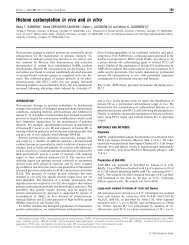Mechanism of horseradish peroxidase inactivation by benzhydrazide
Mechanism of horseradish peroxidase inactivation by benzhydrazide
Mechanism of horseradish peroxidase inactivation by benzhydrazide
You also want an ePaper? Increase the reach of your titles
YUMPU automatically turns print PDFs into web optimized ePapers that Google loves.
614 S. M. Aitken and others<br />
Determination <strong>of</strong> IC 50 values for HRPC inhibition<br />
HRPC (10 nM) was preincubated at 25 ◦ Cin100 mM sodium<br />
phosphate, pH 7.0, containing 1 mM H 2 O 2 and 0.001–50 mM<br />
hydrazide for 1 min prior to assaying activity. Guaiacol-oxidizing<br />
activity was assayed as described above, and the percent remaining<br />
activity was plotted against hydrazide concentration [I]<br />
to generate titration curves that were fit to:<br />
y =<br />
(a − b)<br />
1 + ([I]/IC 50 ) c + b (3)<br />
Figure 1<br />
Structures <strong>of</strong> arylhydrazides and PHZ used in this study<br />
where y is the percentage remaining activity, a is activity at<br />
[I] = 0, b is activity at [I] →∞,andc is the slope when [I] = IC 50<br />
[25].<br />
NZH, naphthoichydrazide; NICH, nicotinic hydrazide.<br />
necessary for the effective inhibition <strong>of</strong> HRPC. The results are<br />
compared with those reported for arylhydrazide inhibition <strong>of</strong><br />
MPO [8–10].<br />
MATERIALS AND METHODS<br />
Lyophilized grade I HRPC was obtained from Roche Molecular<br />
Biochemicals. All hydrazides were purchased from Lancaster<br />
Synthesis (Easgate, Lancs., U.K.) with the exception <strong>of</strong><br />
3-hydroxy<strong>benzhydrazide</strong> and 4-hydroxy<strong>benzhydrazide</strong>, which<br />
were from Aldrich. PHZ was from Sigma. All reagents were<br />
<strong>of</strong> the highest quality available and were used without further<br />
purification.<br />
Determination <strong>of</strong> K I and k inact values for inhibition <strong>of</strong> HRPC<br />
HRPC (10 nM) was preincubated at 25 ◦ C with 1 mM H 2 O 2<br />
and 0–10 mM hydrazide (0–5 mM for BZH) in 100 mM sodium<br />
phosphate buffer, pH 7.0. Aliquots were taken and tested for<br />
activity at time points between 0.5 and 120 min. The assay<br />
solution (200 µl) contained 5 mM guaiacol, the chromogenic<br />
donor substrate, and 1 mM H 2 O 2 in 100 mM sodium phosphate<br />
buffer, pH 7.0, and the final HRPC concentration was 1 nM.<br />
HRPC activity at 25 ◦ Cwas measured spectrophotometrically for<br />
1min at 450 nm with a SpectraMax 190 (Molecular Devices)<br />
microtitre plate reader. The percent remaining activity (ratio <strong>of</strong><br />
initial velocity <strong>of</strong> guaiacol oxidation <strong>by</strong> treated and untreated<br />
HRPC) was plotted against preincubation time, and pseudo-firstorder<br />
rate constants for HRPC <strong>inactivation</strong> (k obs ,min −1 )ateach<br />
hydrazide concentration were calculated from least-squares fits<br />
to:<br />
y = a + b exp(− k obs t) (1)<br />
where y, a and b represent HRPC activity at time t, t =∞<br />
(minimum activity) and t = 0(maximum activity) respectively.<br />
The least-squares fit <strong>of</strong> eqn (2) to plots <strong>of</strong> k obs against hydrazide<br />
concentration [I] yielded values for K I and k inact .<br />
k obs = k inact[I]<br />
k I + [I]<br />
(2)<br />
CO trapping <strong>of</strong> HRPC(Fe II )<br />
Aliquots (2 ml) <strong>of</strong> 100 mM buffer (sodium phosphate at pH 7.0,<br />
8.0 and 12.0; Taps at pH 9.0; Caps at pH 10.0) were de-aerated and<br />
saturated with CO in 3-ml cuvettes fitted with septa. HRPC(Fe III )<br />
was added to 5.5 µM andthecuvettes were flushed with CO for<br />
afurther5min at 25 ◦ Cprior to the addition <strong>of</strong> BZH (25 mM)<br />
from a CO-saturated stock solution. Spectra were recorded<br />
at 30-s intervals for a period <strong>of</strong> 30 min, and compared with a<br />
HRPC(Fe II CO) reference prepared <strong>by</strong> addition <strong>of</strong> 10 µl<strong>of</strong>asaturated<br />
dithionite solution to 2 ml <strong>of</strong> 5.5 µMHRPC(Fe III )saturated<br />
with CO.<br />
O 2 and H 2 O 2 concentration measurements<br />
Solutions <strong>of</strong> 2.5 µM HRPCin100 mM buffer (as detailed in the<br />
previous section) were prepared and aliquots transferred to a micro<br />
oxygen chamber (reaction volume 0.6 ml; Instech Laboratories,<br />
model SYS600) coupled to a dual oxygen electrode amplifier<br />
(Instech Laboratories, model 203). BZH was added to 25 mM<br />
after 1 min and the O 2 concentration was monitored for 30 min.<br />
H 2 O 2 concentrations were determined using the Pierce<br />
perOXoquant kit. Aliquots <strong>of</strong> the BZH-containing solutions<br />
were mixed at a 1:10 ratio with a solution containing 250 µM<br />
ammonium ferrous sulphate, 25 mM H 2 SO 4 , 100 mM sorbitol<br />
and 125 µM Xylenol Orange. Following incubation at room<br />
temperature for 20 min the concentration <strong>of</strong> the resulting<br />
Xylenol Orange–Fe II complex was determined <strong>by</strong> comparing the<br />
absorbance at 560 nm with a standard curve. The concentration<br />
<strong>of</strong> the H 2 O 2 stock solution used to prepare the standard curve<br />
was determined spectrophotometrically (ε 240 = 43.6 M −1 · cm −1 )<br />
in water.<br />
Isolation and characterization <strong>of</strong> modified haems from HRPC<br />
A haem-extraction protocol described <strong>by</strong> Ator and Ortiz de<br />
Montellano [2] was used with minor modifications. Sufficient<br />
inhibitor (I = 2–6 mM BZH or I = 3–8 mM PHZ depending on<br />
the I/H 2 O 2 ratio; see Figure 3E, below) and H 2 O 2 (3–6 mM<br />
H 2 O 2 depending on the I/H 2 O 2 ratio; see Figure 3E, below) were<br />
added to 2.5-ml solutions <strong>of</strong> 20 µMHRPCtoinhibit its guaiacoloxidizing<br />
activity within 2 min. Following a 10-min incubation at<br />
room temperature the inactivated HRPC solutions were desalted<br />
<strong>by</strong> gel filtration on 9-ml G-25 columns (PD10; Amersham<br />
Biosciences). The protein-containing eluates (approx. 3.5 ml)<br />
were then acidified with 1 ml <strong>of</strong> glacial acetic acid saturated with<br />
NaCl, and the haems were extracted with three 3-ml portions<br />
c○ 2003 Biochemical Society








